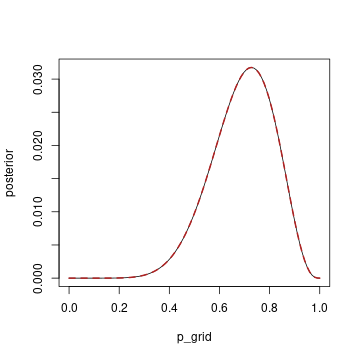<style type="text/css"> .title-slide .remark-slide-number { display: none; } </style> <div> <style type="text/css">.xaringan-extra-logo { width: 110px; height: 128px; z-index: 0; background-image: url(fig/bl_logo.png); background-size: contain; background-repeat: no-repeat; position: absolute; top:2em;right:2em; } </style> <script>(function () { let tries = 0 function addLogo () { if (typeof slideshow === 'undefined') { tries += 1 if (tries < 10) { setTimeout(addLogo, 100) } } else { document.querySelectorAll('.remark-slide-content:not(.title-slide):not(.inverse):not(.hide_logo)') .forEach(function (slide) { const logo = document.createElement('a') logo.classList = 'xaringan-extra-logo' logo.href = 'https://www.lucs.lu.se/bayes/' slide.appendChild(logo) }) } } document.addEventListener('DOMContentLoaded', addLogo) })()</script> </div> .h1.f-headline.fw1[ Bayesian Analysis ] .h2.f-subheadline.lh-title[ and Decision Theory ] <br><br> .f1[ Conjugate and linear models ] .f3[ NAMV005<br> Lund 2022 ] --- # Course content |Topic|Format| Date | |-----|------|------| | Introduction to Bayesian inference and subjective probability <br> Conjugate models| Review <br> Lecture | 17 Jan 2022 | | Conjugate models (review and exercises) <br> Modern Bayesian analysis with MCMC | Review <br> Lecture | 24 Jan 2022 | | Modern Bayesian analysis with MCMC (review and exercises) <br> Hierarchical models | Review <br> Lecture | 31 Jan 2022 | | Hierarchical models (review and exercises) <br> Decision theory <br> Literature seminar | Review <br> Lecture <br> Seminar | 07 Feb 2022 | --- # Recap 1. Logical probability ("degree of plausibility" intepretation) 1. Urn drawing with "garden of forking data" - for each possible explanation of the data - Count all the ways the data can happen - Explanations with more ways to produce data are more plausible 1. Globe-tossing problem. Binomial model to find out proportion of water on the planet 1. Grid approximation to calculate posterior density (relative plausibility) at fixed (discretized hypotheses) -- ## Today 1. Conjugate models. Globe tossing with beta-binomial model. When you don't need to approximate 1. Linear models. Gaussian model assumptions. 1. Live coding: - Introduction to `brms` and the first model - Peeking under the hood. Our own first program in Stan. - Data wrangling and visualization of posterior draws. --- # Conjugate models Wikipedia: Beta distribution https://en.wikipedia.org/wiki/Beta_distribution When we use Beta prior with Binomial likelihood the posterior is also a Beta distribution. This property is called "conjugacy", introduced by Raiffa & Schlaifer (2000), first edition published in 1961. https://en.wikipedia.org/wiki/Conjugate_prior **Question** How would you describe the typical behavior of a `\(Beta(\alpha, \beta)\)` variable `\(\pi\)` when `\(\alpha=\beta\)`? Using the same options as above, how would you describe the typical behavior of a `\(Beta(\alpha, \beta)\)` variable `\(\pi\)` when `\(\alpha>\beta\)`? For which model is there greater variability in the plausible values of `\(\pi\)`, `\(Beta(20,20)\)` or `\(Beta(5,5)\)`? `$$E(\pi)=\frac{\alpha}{\alpha+\beta} \\ Mode(\pi)=\frac{\alpha-1}{\alpha+\beta-2}\\ Var(\pi)=\frac{\alpha\beta}{(\alpha+\beta)^2(\alpha+\beta+1)}$$` --- # Comparing to conjugate model solution For conjugate models posterior hyperparameters can be found in closed form. For Beta-Binomial: `$$\alpha+\sum_{i=1}^{n} x_{i},\quad \beta+\sum_{i=1}^{n} N_{i}-\sum_{i=1}^{n} x_{i}$$` In our globe tossing example we have a single datapoint `\(N=9\)`, `\(x=6\)`. Therefore if our prior is `\(Beta(3,1)\)` the posterior should be `\(Beta(3+6, 1+9-6)\)` or `\(Beta(9,4)\)`. Lets compare it to grid-approximated solution. .pull-left[ ```r library(tidyverse) n <- 1e2 p_grid <- seq(0,1, length.out=n) prob_p <- dbeta(p_grid,3,1) prob_data <- dbinom(6, size=9, prob = p_grid) posterior <- prob_data*prob_p posterior <- posterior/sum(posterior) posterior_a <- dbeta(p_grid, 9, 4) posterior_a <- posterior_a/sum(posterior_a) plot(p_grid, posterior, type="l") lines(p_grid, posterior_a, lty=2, lwd=2, col="firebrick") ``` ] .pull-right[ <!-- --> ] --- background-image: url(https://earthsky.org/upl/2012/11/retrograde-motion-mars-july200-February2006-Tunc-Tezel.jpg) background-size: 20% 25% background-position: 90% 10% # Geocentrism + Descriptively accurate + Mechanistically wrong + General method of approximation + Known to be wrong (Taken too seriously?) ## Linear Regression + Model for **mean** and **variance** of a variable (as a weighted sum of other variables) + Many fancy names (ANOVA, t-test, ANCOVA, MANOVA, etc) + Normal distribution for error term (summed fluctuations) + Estimated with least squares + Variable itself does not have to be normally distributed `$$y_i \sim Normal(\mu_i, \sigma)\\ \mu_i=\alpha+\beta x_i$$` Each x value has a diferent expectation, `\(E(y|x) = \mu\)` --- background-image: url(https://www.andrewheiss.com/blog/2021/11/10/ame-bayes-re-guide/chelsea-meme.jpg) background-size: 30% background-position: 90% 80% # General brms syntax .pull-left[ Borrowing multilevel formula syntax from [`lme4`](https://rpsychologist.com/r-guide-longitudinal-lme-lmer). ``` response | aterms ~ pterms + (gterms|group) ``` where `pterms` is population-level effects (same across observations), `gterms` is group-level effects varying across (one or more, possibly nested) grouping variables specified by `group`. Optional `aterms` provide opportunity to specify additional information about the response variable useful in meta-analysis, as well as in modeling censored or truncated data. See Buerkner(2017) for details. Also `1` means intercept and `0` means, explicitly, no intercept. See `?brmsformula` to learn more. ## Lets get coding! ] --- # References Acree MC. 2021. The Myth of Statistical Inference [Internet]. Cham: Springer International Publishing; [accessed 2022 Jan 6]. https://doi.org/10.1007/978-3-030-73257-8 Bürkner P-C. 2017. Advanced Bayesian Multilevel Modeling with the R Package brms. arXiv:170511123 [stat] [Internet]. [accessed 2022 Jan 23]. http://arxiv.org/abs/1705.11123 Clayton A. 2021. Bernoulli’s fallacy: statistical illogic and the crisis of modern science. New York: Columbia University Press. McElreath R. 2020. Statistical Rethinking: A Bayesian Course with Examples in R and Stan [Internet]. 2nd ed. New York, NY: Chapman and Hall/CRC; [accessed 2020 May 3]. https://doi.org/10.1201/9780429029608 Raiffa H, Schlaifer R. 2000. Applied statistical decision theory. Wiley classics library ed. New York: Wiley. Sahlin N-E. 1990. The philosophy of FP Ramsey. [place unknown]: Cambridge University Press. --- class: center, middle # Thanks! Slides created via the R package [**xaringan**](https://github.com/yihui/xaringan). The chakra comes from [remark.js](https://remarkjs.com), [**knitr**](https://yihui.org/knitr/), and [R Markdown](https://rmarkdown.rstudio.com).